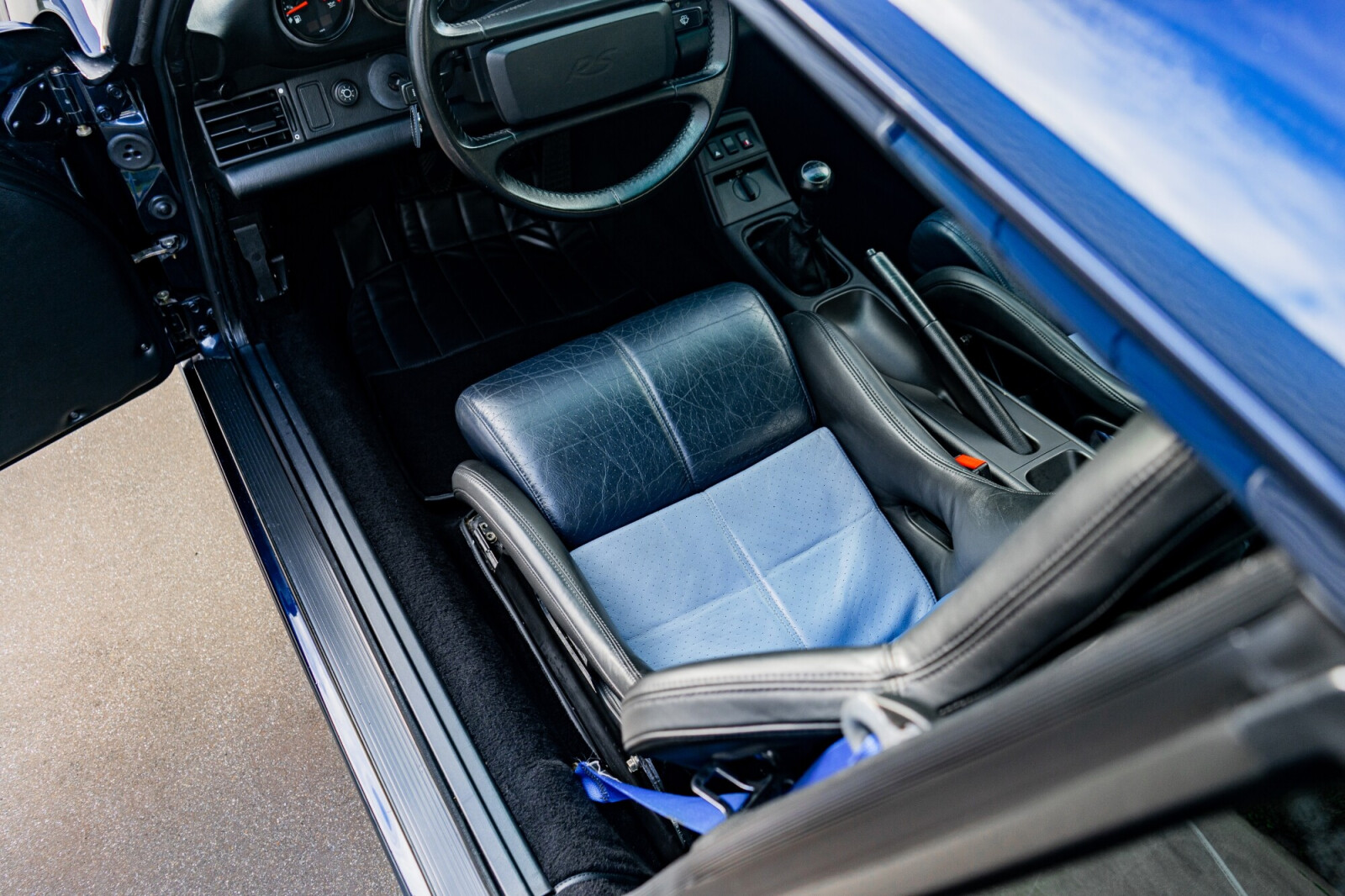Porsche 964 RS
- Chassis: WP0ZZZ96ZNS4906**
- Engine: 3.600cc
- Transmission: Manual gearbox
- Mileage: 111330 km
- Color: Midnight Blue Metallic (L37W) / Black / Darkblue / Maritimblue / Lightblue interior (NS)
- Delivered new in Germany
- One of 2,276 examples of the Carrera RS
- Rare Midnight Blue Metallic paintwork
- Factory 964RS magnesium wheels
- Extended service history
'What the RS has done is take the technical brilliance of the latest Carreras and put back the missing excitement of some earlier, less pampering generations.' – Brian Laban, Performance Car magazine.
This 964 RS
The car was delivered new in Germany to its first owner on 23th of June 1992. Little is known about its early history but after only 6 years the car arrived in Belgium. Since then the car has had four Belgian owners over 25 years; each maintaining the car as it should; including a full respray in 2012. Bought by the last owner in 2016; he recently decided to sell the car after merely haven driven 2.000kms with the car.
Today the 964 is presented in excellent 'showroom' condition, currently displaying a genuine total of only 111.330 kilometres on the odometer. This example is finished in Midnight Blue Metallic over blue interior. Extended service history is recorded in accompanying invoices; older titles, technical inspection and more. The car also comes with its original owner's manual and key code. The magnesium 17″ Cup wheels are mounted with N coded Michelin Pilot Sport tires dated 2020-'21.
Beautifully presented in and out, this Carrera RS is accompanied by its original magnesium wheels, a tool roll, a space-saver spare wheel, and a warning triangle.
Unmolested and used (as a real RS is intended), this stunning 964 is finished in the extraordinary colour of Midnight Blue Metallic and is know looking for a passionate new owner.
OWNERS
- 1992 : Germany
- 1998 : Mr. L.C. - Belgium
- 2011 : Mr. J.A.
- 2014 : Mr. F.L
- 2016 : Mr. B.D.L
- 2023 : RSC
MILEAGE
- 1998 : 59.300km
- 2000 : 77.047km
- 2001 : 81.437km
- 2002 : 87.900km
- 2003 : 91.350km
- 2004 : 92.528km
- 2005 : 94.311km
- 2006 : 96.460km
- 2007 : 98.333km
- 2008 : 99.637km
- 2009 : 100.705km
- 2010 : 103.293km
- 2011 : 103.500km
- 2012 : 105.888km
- 2013 : 107.500km
- 2014 : 108.890km
- 2015 : 109.385km
- 2016 : 109.680km
- 2017 : 109.785km
- Today : 111.330km
More insight on the 964RS
Evoking memories of the legendary 2.7 and 3.0-litre RS and RSR 'homologation specials' of the 1970s, in 1991 Porsche introduced the Type 964 Carrera RS. A lightweight variant like its illustrious forebears, the beautiful newcomer was based on the 'Carrera Cup' competition car and sold in Europe only.
The Carrera RS retained the 3.6-litre engine, albeit boosted in maximum output to 260bhp and equipped with a lightened flywheel for improved response. The G50/10 five-speed transmission featured closer ratios, an asymmetrical limited-slip differential, and steel synchromesh, while the suspension was lowered and stiffened. The 0-100km/h time dropped to 5.4 seconds and the Carrera RS had a top speed of 260km/h.
The interior was stripped out completely and the power steering, power windows and seats, rear seats, air conditioning, cruise control, sound deadening material, and stereo system removed. Two lightweight racing bucket seats were fitted instead. The front bonnet was made of aluminium and the chassis was seam welded, while the side windows were made from thinner and lighter glass. Rounding off this radical exercise in weight reduction, the Carrera RS was equipped with 17" Cup magnesium wheels. The result was a total weight saving of around 150kg compared to the Carrera 2, transforming the RS into a faster, more agile, and more responsive car.
Brian Laban found that any feeling of remoteness or soft touch had gone completely, and reckoned that the controls never felt more solid or precise. In his opinion the Porsche could not be faulted, the verdict being that the Carrera RS was 'exactly what a performance car should be'.
- Mark
- Porsche
- Model
- 964 RS
- VIN number
- WP0ZZZ96ZNS4906**
- First use
- 23/06/1992
- Mileage
- 111330 km
- Power
- 260 hp
- Fuel
- Gas/Petrol (normal)
- Transmission
- Manual gearbox
- Color
- Midnight Blue Metallic (L37W)
- Interior
- Black / Darkblue / Maritimblue / Lightblue interior (NS)

























































